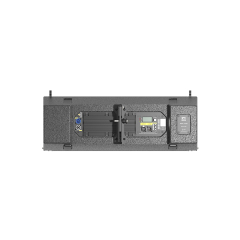There are some key characteristics embodied in what makes a pro audio speaker of high quality and ensures performance, durability, and versatility for professional applications. The most crucial part of them is frequency response. It should cover a broad frequency response too (sub 20 Hz to ultrasonic range up towards the human hearing ceiling of around about 20 kHz) it must be able and willing to play down in the depths, right through mids and right out into space. That range allows for every note of the audio to be played, without colouring any part in a good or bad way. A speaker that lacks a full frequency response could miss the deep bass necessary for most (but not of all) electronic dance music or jazz — as well any clarity needed in, say vocals at those same live events.
Another characteristic of subwoofer boxes that sets them apart is their power handling capacity. A pro audio speaker that is well-designed will have a continuous power rating (RMS) appropriate to the application supported by spike or peak level wattage large enough for high signal count dynamic range. An example could be a speaker which has 500 watts RMS and peaks at about 1000 watts, this means that you can use it from small to medium-large sized gigs but sound level will always remain nice without any seepage even on the loudest volumes. This can be essential for moments such as concerts, wherein your speakers need to bear the brunt of sharp spikes in sound without a trace of clipping or deformity.
It is a very important parameter because it determines how effectively the speaker works. According to industry standards, a good speaker can manage 95 dB SPL at 1 watt/1 meter. A speaker's sensitivity rating expresses the volume of sound the speaker will produce with 1 watt of power: higher means more output. This energy saving is crucial, especially in an office environment where many speakers are being used reducing overall power and improving system efficiency.
For pro audio speakers that are which often moved and used outdoors, durability is crucial. Solid speakers typically are built with more robust materials, like high-density plywood or reinforced plastic, and boast weather-resistant features — coatin grilles for instance provide another layer of protection against the elements. This sturdy design means the speakers are built to take whatever’s thrown at them in terms of stage or festival life, whether they’re used indoors, outdoors.

Of course, the driver quality has a huge say in how they sound overall as well. The best pro audio speakers typically include high-quality woofers and tweeters with drivers designed to accurately reproduce a wide range of frequencies. These drivers also utilize high-quality materials including neodymium magnets and titanium diaphragms to enhance the power handling, clarity, and responsiveness. A woofer featuring a lighter, quicker neodymium magnet may provide tight-accurate bass reproduction.
This is accomplished in part by crossover networks within the speaker, which direct audio signals to each driver so that they are responsible for reproducing any given frequency range. Because of the fact that each of these two drivers contributes in a different way to reproduction, sophisticated crossover networks are utilized by high-quality speakers which reduce phase distortion and ensure a smooth transition between how low and High-frequency frequency. It is important in multi-way speakers for example, you need the transition between bass and midrange frequencies are perfect when sound clarity needs to be maintained.
This is a key factor + versatility and connectivity. The kind of pro audio speaker to go for are the models which offer various inputs such as XLR, TRS and RCA in order to support a variety of audio sources that may need compatibility with other sound systems. Also, modern speakers often come with their own internal digital signal processing (DSP), which can be used to tailor the sound via built-in EQs, delays and crossover points. Such flexibility is obviously necessary to optimize the performance of your speakers in a wide range of venues and audio systems.
Sound quality is something that the experts in this field always point out, due to which they say professional audio equipment. There is a famous quote by legendary audio engineer, Bruce Swedien that goes like this: “The more clarity you have in your sound, the more depth and dimension can possess any mix” What is clear from this statement, however, is that a decent pro audio speaker will be needed in order to hear anything at all and stave off the noise echo generation.
This is the bottom line: pro audio speakers are judged based on how wide of a frequency response they produce, its ability to handle power and heat built up from powering it for long periods of time without distorting or blowing completely,A/B tests against existing similar drivers that many engineers have used in similar applications (Replacements),Build quality – The type/quality of driver elements/fabrication,Ease/cost effectiveness with which replacement parts can be obtained. This makes it an essential tool for any audio professional as these attributes make the speaker able to deliver truly great sound performance.
